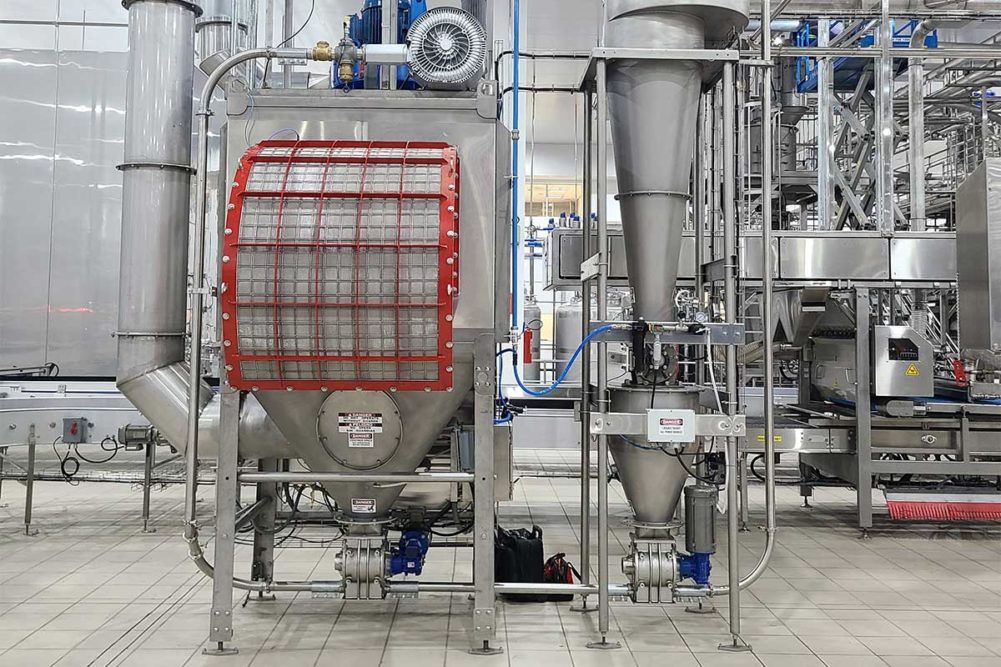Nobody likes to talk about it, but insect infestation can be an issue, especially when storing flour in warm climates.
To avoid such issues, Ken Girts, director of sales and marketing, Fred D. Pfening Co., recommended emptying and cleaning bulk flour silos and bins monthly to stay ahead of the life cycle of the flour beetle, which is about 29 days.
Some bakeries use sifters along with impact milling machines to eliminate infestations, he added.
When adding a bulk flour system, bakeries should properly size the storing capacity according to their weekly flour consumption and avoid the oversizing of storage vessels, noted James Toole, ingredient handling manager, Gemini Bakery Equipment/KB Systems.
“Moving quickly through the inventory will help avoid the possibility of infestation,” he said.
Additionally, Toole recommended removing any harborage areas within the storage units and conveying system to reduce the risk of infestation occurring.
Sometimes a vacuum instead of a pressurized flour conveying system may be an option, according to Pieter Van Hoeck, business development manager, North America, Spiromatic, which offers both types of ingredient handling operations.
He said vacuum systems tend to be more dust-free while pressurized systems are often preferred when conveying large volumes of ingredients over longer distances.
Limiting dust could prevent all sorts of problems.
“Many food ingredients will generate mold or organisms that pose health risks if the dust is not contained in the transfer process or if equipment surfaces are not cleaned and disinfected routinely,” explained David Kennedy, business development manager, Vac-U-Max. “Surface contamination on containers and machinery can lead to costly product recalls and drops in brand confidence. Vacuum conveying uses suction to transfer powders, so if there is a leak, it leaks inward and does not contribute to fugitive dust problems.”
The dust issue remains a major concern for food and worker safety, which is why systems that pneumatically convey flour must comply with the latest National Fire Prevention Association (NFPA) codes in the United States and ATEX, which is an acronym for the European “Atmosphere Explosible” safety standards.
Pfening designs dry ingredient systems to comply with NFPA standards.
“We, however, ask that our customers consult with the local municipality’s fire marshal’s department and their insurance carrier to confirm explosion equipment requirements,” Girts said.
Fire and explosion safety systems are based on the specific material characteristics of the ingredient being handled, said Tom Leach, national sales manager, pneumatic conveying systems, Camcorp, a member of the Scheuch Group.
“Some of the most popular means of mitigating the risks of explosions are through the use of rupture panels, which allow a deflagration to be directed in a safe manner,” he explained. “Indoor facilities present a larger challenge with many customers opting for suppression-type systems that detect an event and prevent the deflagration from happening.”
David Rodrigues, applications engineering manager, Zeppelin Systems USA, pointed out that NFPA regulations are routinely updated to enhance safety compared to just a few years ago. For example, the codes now require isolation values on all tubing of every diameter while the number of explosion relief panels has increased.
“Because the regulations are more rigid for protecting employees, the codes are adding costs to new, updated ingredient handling systems,” he observed.
Technology has also improved. Rodrigues suggested systems now can include food-grade powdered chemical fire suppression in lieu of mechanical alternatives.
“The system works like a fire extinguisher for industrial purposes,” he said. “It’s less costly initially, but it may require more maintenance on equipment in the long run.”
Other newer technology would include passive explosion isolation based on the existing technology of flameless venting by companies such as CV Technology, which offers NFPA-compliant systems, said Blaine Johnston, process design manager, Zeppelin Systems USA.
The technology, which can be retrofitted to existing systems, essentially provides flameless venting in low dust-loaded lines, like air leaving a filter receiver. That’s especially critical with indoor silos/bins or where a bakery may not be able to exhaust pressure from a fire or explosion to the outside of the building.
Meanwhile, Laramore, a part of Shick Esteve, offers a fully integrated flour reclaim system. For more than four decades of operation, Laramore has developed and introduced several design features, ensuring that its reclaim systems offer long-term performance and durability. Laramore now provides a replacement program for its legacy units in operation that do not meet current NFPA and ATEX standards.
The evolving NFPA standards often require older systems to be upgraded to combat combustible dust. Jerry Murphy, vice president of sales, Gemini/KB Systems, noted the company assembled an in-house engineering team to review the latest regulations and created a field modification initiative to the design that aligned with the updated NFPA codes.
“We have safety switches on all access points on our 3-hp sifter,” he said. “These switches will shut the system down if any access is left open. This system will prevent any unexpected flour breach into the sifter area. Our overfill protection has been a standard on our bins since the first units were ever manufactured. This system will prevent the bulk truck from overfilling our indoor storage bins.”
Over the years, Toole added, Gemini/KB Systems has updated its equipment to activate a safety valve system when the bin or silo senses an overpressure rating in the bin or in the conveying line.
The company also provides an audit of its older legacy systems where a senior technician travels to the bakery, inspects the current operation and offers updated products or services that are necessary to comply with current NFPA codes.
This article is an excerpt from the March 2024 issue of Baking & Snack. To read the entire feature on Ingredient Handling, click here.





